15 Types of Echeveria Succulents (With Pictures)
-

- Last updated:

Succulents have exploded in popularity over the past few years. It is not hard to see why everyone is going crazy for succulents. They have a distinctive look, they are super low maintenance, and they are affordable. Echeveria is one type of succulent with many different varieties that come in many different shapes, sizes, and colors. Some of these plants can grow up to 2 feet in diameter and sprout tall, vibrant flowers. If you are planning on getting into succulents, you have to know about echeverias.
What Is An Echeveria Succulent?
Echeveria is a class of succulents known for its rose shape. Echeverias’ bodies are known as rosettes due to their shape. There are many types of succulents, and each one is determined by its size and shape. There are dozens of different varieties of echeverias grown and bred for their distinct shape and bright colors. Echeverias are typical succulents that require typical succulent care. They like bright sunlight and moderate amounts of water. They do not do well in the cold, so be sure to keep them inside for the coldest parts of the year.
Without further ado, here are 15 different types of unique echeveria succulents with facts and pictures included.
The 15 Types of Echeveria Succulent
1. Echeveria Agavoides
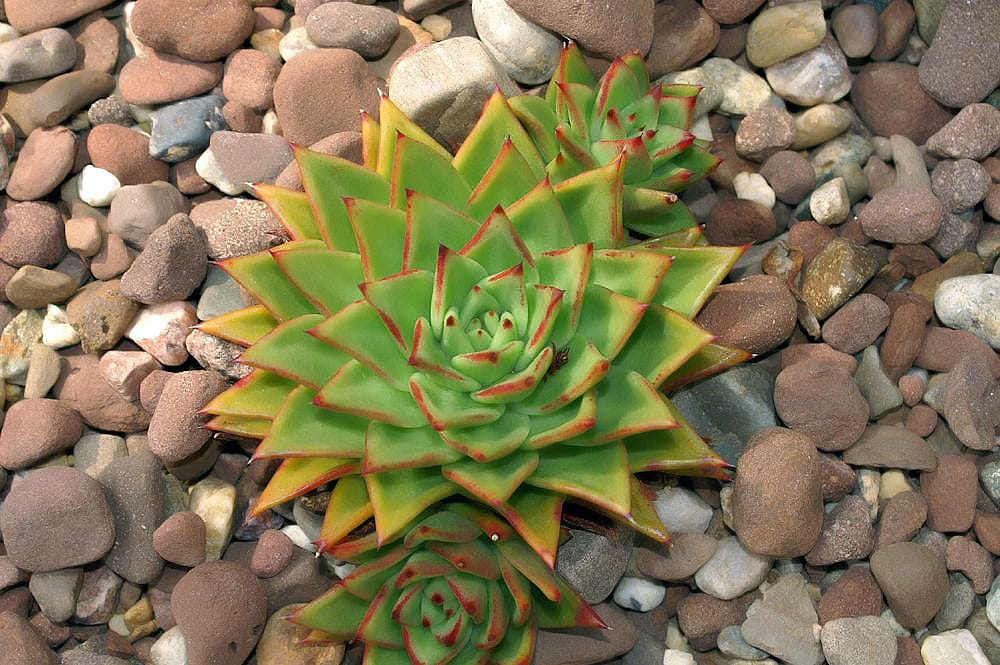
| Size: | Medium |
| Color: | Green with red accents |
The Echeveria agavoides is also known as lipstick succulent. This plant grows up to two feet tall and two feet wide and has a distinctive color and shape. The term ‘agavoides’ comes from the agave plant, which it resembles. The nickname lipstick comes from the red color that appears on its green leaves. The leaves get outlined in a red color giving it the appearance of wearing lipstick.
2. Black Prince
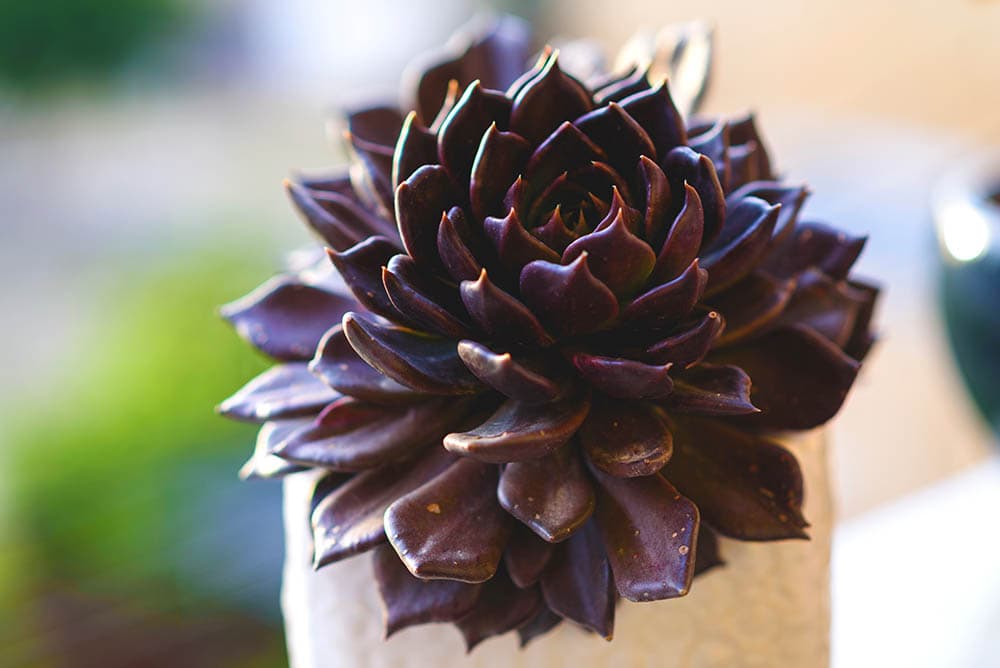
| Size: | Small |
| Color: | Deep emerald and dark purple |
Echeveria Black Prince is a variety of succulent with an odd name. The name comes from its striking appearance. While most succulents are a bright green color, this one is a moody purple and green that reminds you of a storm cloud. Other than its strange appearance, the black prince is a typical succulent that will grow to around six inches in size. Black Prince will even crown itself with a red flower in the fall and winter months.
3. Black Knight

| Size: | Medium |
| Color: | Black |
Alongside the Black Prince stands the Black Knight. The Echeveria Black Knight is a larger and pointier version of the Black Prince. It has large thick leaves and a deeper black color than the Black Prince. The Black Knight succulent is a medium-sized plant. Despite its sturdy name, the Black Knight will not tolerate frost or freezing temperatures. If you want your knight to live to see another season, you should bring them inside during the winter.
4. Afterglow
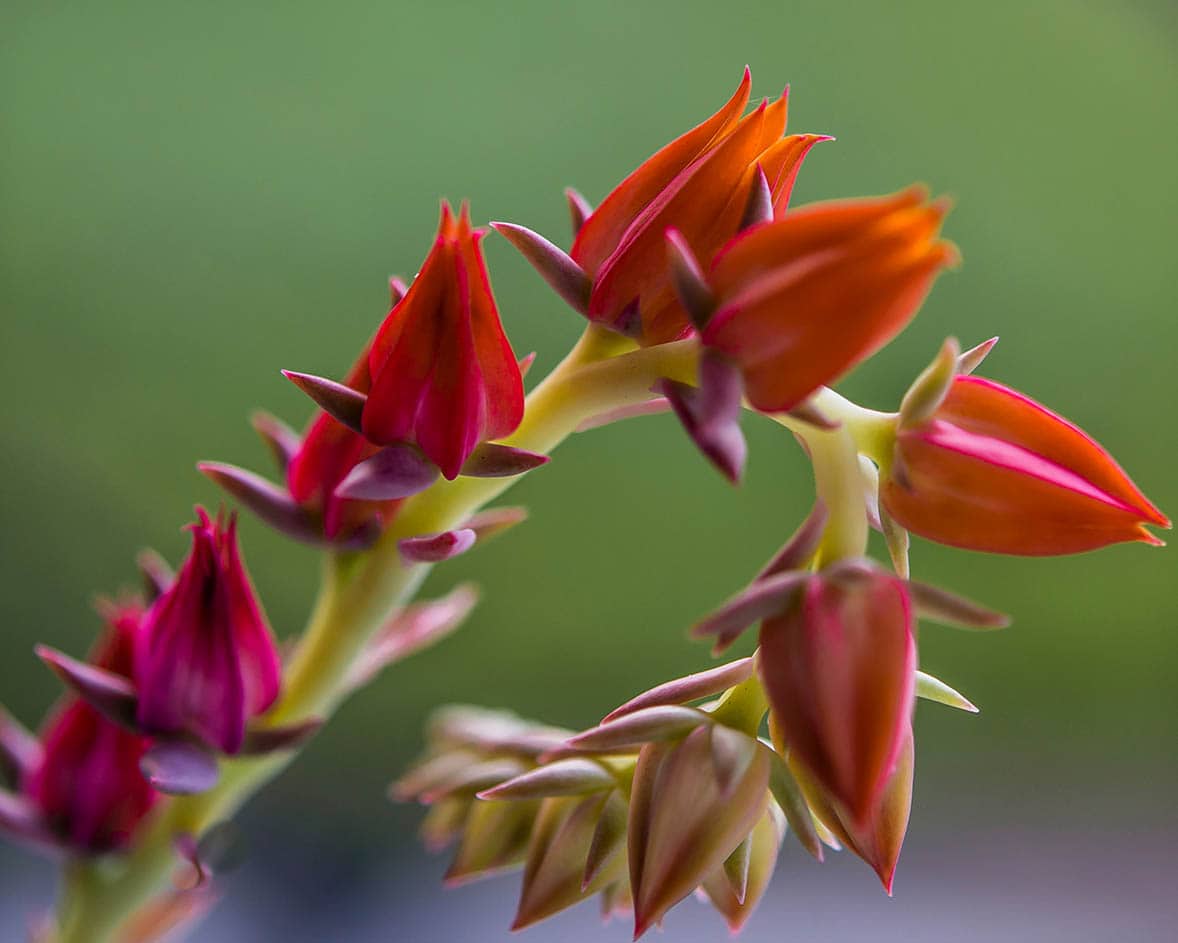
| Size: | Medium |
| Color: | Green and pink |
Echeveria Afterglow is reminiscent of a sunset. It has deep green leaves and touches of pink, orange and red around the edges. The name comes from the vibrant colors that appear after a particularly stunning sunset. This is a medium-sized succulent that can grow as large as 2 feet in diameter in an ideal climate. Many people are attracted to Afterglow for its gorgeous colors and eye-catching size.
5. Neon Breakers
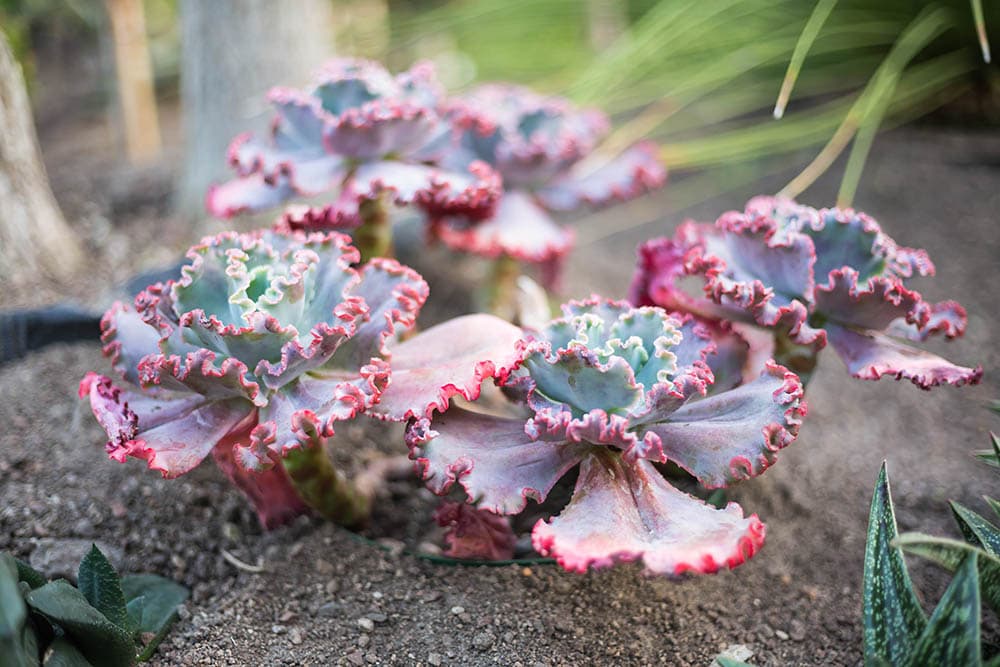
| Size: | Small |
| Color: | Pink and purple |
Echeveria Neon Breakers are brightly colored succulents desired for their appearance. This plant is pink and purple all over with just a small green center. The leaves are ruffled, giving them a unique look. In the spring, the color is enhanced by bright pink flowers that overgrow the purple body. Neon breakers are a small variant that only grows 3 inches in some cases. To keep the vibrant colors, be sure to avoid overwatering the plant and keep it in bright sunlight.
6. Echeveria Ruffles
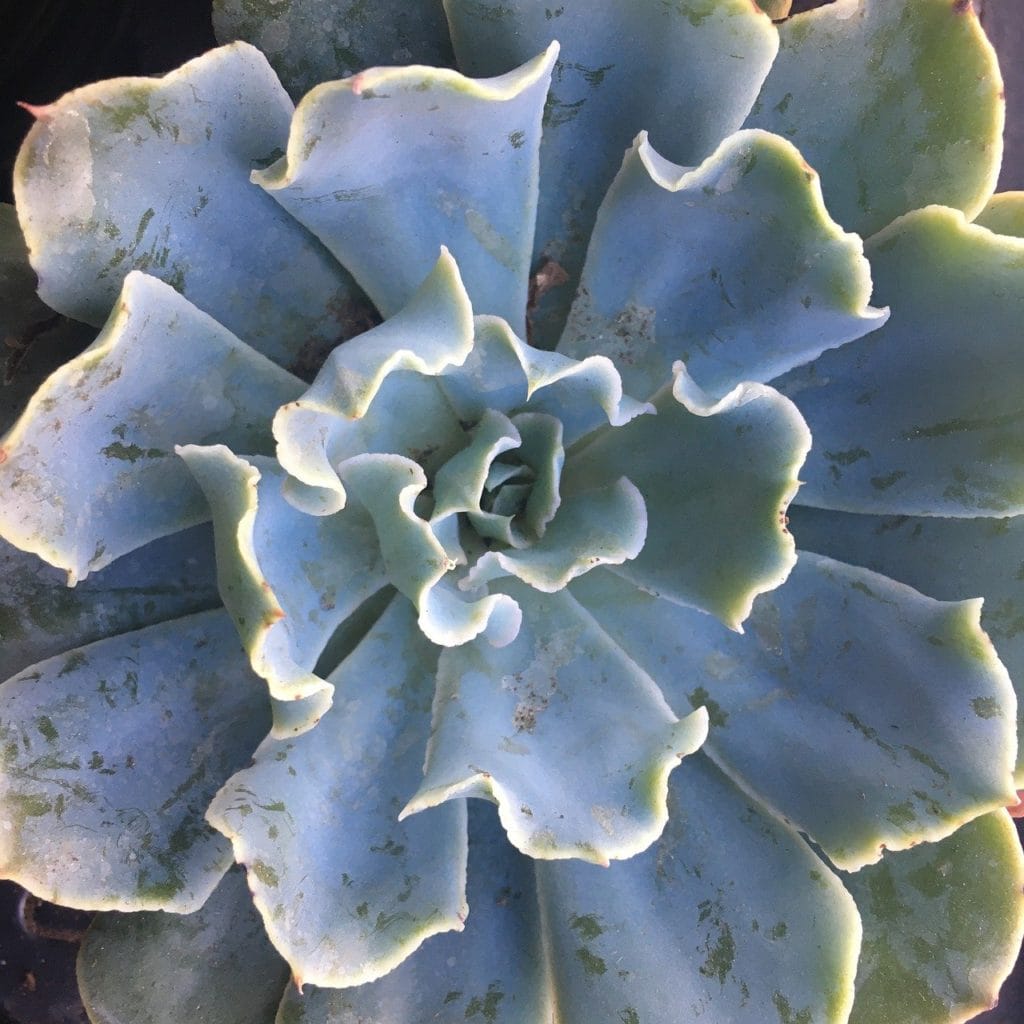
| Size: | Medium |
| Color: | Green |
Ruffles are one of the most popular variants of succulents. This plant has a great shape that is similar to that of a cabbage. The ruffled edges of the leaves are what lend this succulent its name. But the ruffles are not the only thing that is unique about this plant. It has a beautiful color, and the edges will turn red if grown in potent sunlight. When it is time to flower, Echeveria Ruffles grow red and orange flowers which only adds to its unique appearance.
7. Gorgon’s Grotto
| Size: | Medium |
| Color: | Gray and red |
Gorgon’s Grotto is an interesting succulent hybrid. The name comes from the fact that this succulent is shaped like an underwater coral reef. Some people say that it looks like lettuce or cabbage. Either way, the shape of this plant really draws the eye. The leaves of Gorgon’s Grotto are a pale greenish-gray color. Like many echeverias, Gorgon’s Grotto will develop bright red edges when left to grow in full sunlight.
8. Sahara
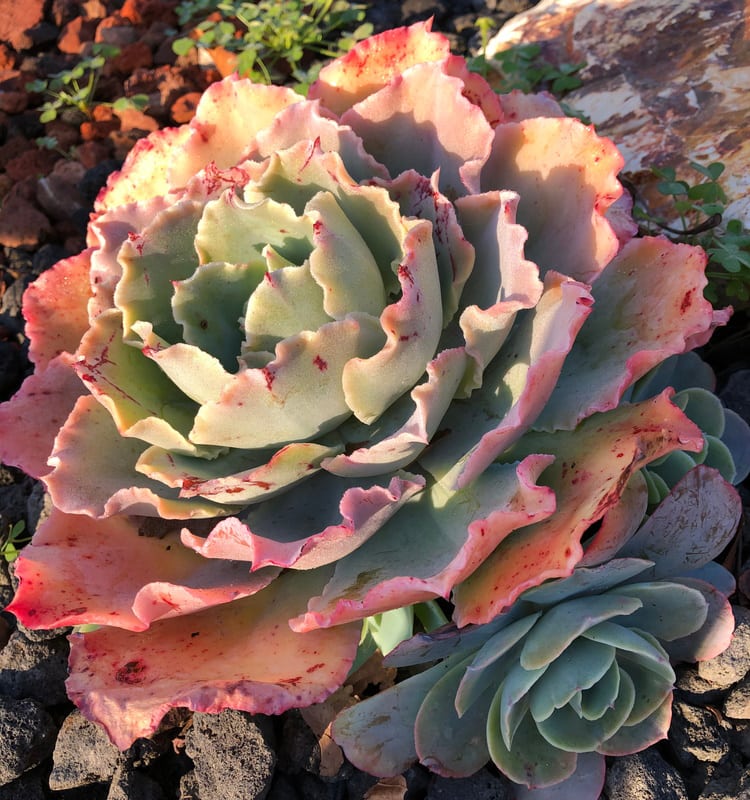
| Size: | Medium |
| Color: | Light green |
Sahara is a cabbage-looking succulent that enjoys full sun. It is an extremely hardy plant that is resistant to drought. The Sahara succulent is known for its bright pink flowers that bloom during the summer. When this plant is in full bloom, it really is a sight to behold. Healthy Saharas can grow up to a foot in size. A full-sized Sahara in bloom is something you will enjoy year after year.
9. Blue Rose
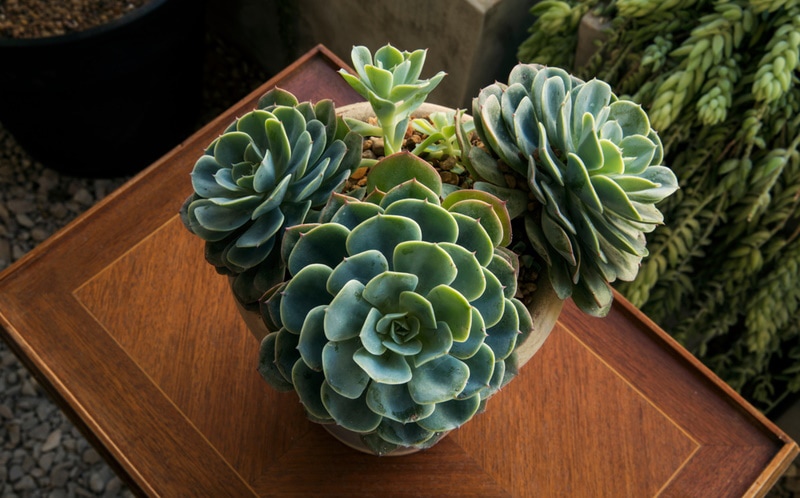
| Size: | Small |
| Color: | Bluish-green |
Echeveria Imbricata, also known as Blue Rose, is a very classic-looking succulent. It has a traditional succulent shape, and it grows in a tight, petite rosette. Not every succulent breed has to have a shtick. If you are looking for an adorable succulent that can adorn your myriad pots both inside and outside blue rose is an excellent choice. Like many echeverias, Blue Rose will develop flowers and red-tinged tips during the summer.
10. Topsy Turvy

| Size: | Small |
| Color: | Green |
The Echeveria Topsy Turvy has an odd quirk. When its leaves start growing outward, they eventually curl back on themselves and start growing back towards the center. This results in some unique shapes and the appearance of the plant being topsy-turvy. This plant is a small succulent that is very sensitive to being overwatered. If you want to view the unique leaves, do not overwater them and let them do their own thing.
11. Paul Bunyan

| Size: | Small |
| Color: | Green |
If you are looking for a succulent that is truly different from its peers, you will want to look into the Paul Bunyan. This variety has lumpy protruding growths that appear on and near its leaves. The result is a bumpy mess that is hard not to notice. While many succulents are admired for their symmetry and uniformity, the Paul Bunyan is the exact opposite. This succulent will be a guaranteed conversation piece.
12. Violet Queen

| Size: | Small |
| Color: | Green |
Violet Queen is not violet colored, but it is pretty looking. This succulent is coveted for its distinctive shape. It furls out in a pleasing circular pattern that radiates out from the center. The result is a succulent that looks like a complex flower bud, like a rose or a camellia. The tips will get the faintest shade of pink during the summer months. The Violet Queen is a small succulent, and it will spread under the right conditions.
13. Silver Onion

| Size: | Small |
| Color: | Pale green |
Silver Onion is known for its distinctive onion shape. The plant starts out with a tightly wound rosette when it is young, and it slowly unfolds as it ages. This unique process gives Silver Onion some movement and character. The color is a pale green that looks almost silver, hence the name silver onion. The Silver Onion is a small succulent that tops out around seven inches in diameter. It looks great with other pale-colored succulents.
14. Perle von Nurnberg
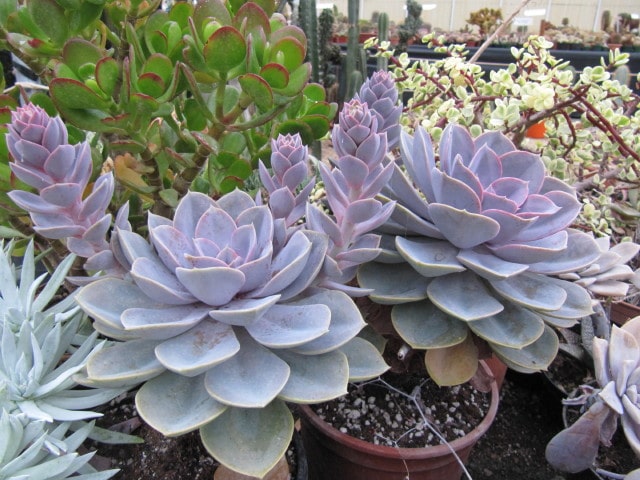
| Size: | Small |
| Color: | Green and blue |
The Echeveria Perle von Nurnberg has both a strange name and a strange appearance. The Perle von Nurnberg is bred for its metallic-hued leaves that have a blue undertone. Pictures do not do this succulent justice. In person, they strike a remarkable appearance. The metallic appearance is rare and highly desirable. The Perle von Nurnberg is a hybrid plant developed in the 1930s in Nurnberg, Germany, which is where the name is derived from.
15. Echeveria Setosa

| Size: | Small |
| Color: | Green |
Echeveria Setosa is known as the Mexican Firecracker. At first glance, it does not appear to be much different than a standard succulent until you notice the tiny hairs and spines that appear all over. The Echeveria Setosa grows in low flat mats rather than bulbous rosettes. The name is derived from the succulent flowers which bloom in the spring. The Mexican firecracker grows tall, yellow, and red flowers that look like fireworks.
Tips for Growing Echeveria Succulents
Echeveria succulents are very typical in what they like. A few of the breeds have more specific needs, but most of them will be perfectly happy being treated like every other succulent. Echeverias do not like to be overwatered. They like strong direct sunlight. They like being in warm areas. Succulents cannot survive a hard freeze or even frost in most cases. If you plan on keeping your succulents outside, you have to make a plan for bringing them inside during the winter, or else they will die. Succulents do very well in pots as opposed to being planted directly into the ground. Pots make it easy to manage their water intake and make it easy to move them in case of a cold snap.
Succulents enjoy the occasional cactus food or fertilizer. Most of the time a succulent will do just fine with a little water and plenty of sunlight. You can largely leave them alone unless something is going wrong. That is why they are so popular as houseplants.
- Related Read: 19 Types of Mini Succulents (With Pictures)
Conclusion
Echeverias are beautiful. They are easy to take care of, and there are tons of unique varieties to choose from. That is why this family of plants is becoming so popular among people of all ages. They make great houseplants, they have a unique look, and they usually won’t die on you without good reason. Outside of these 15 variants, there are more obscure hybrids and morphs being created by succulent enthusiasts as we speak.
Featured Image Credit: Beate Panosch, Shutterstock
Contents

